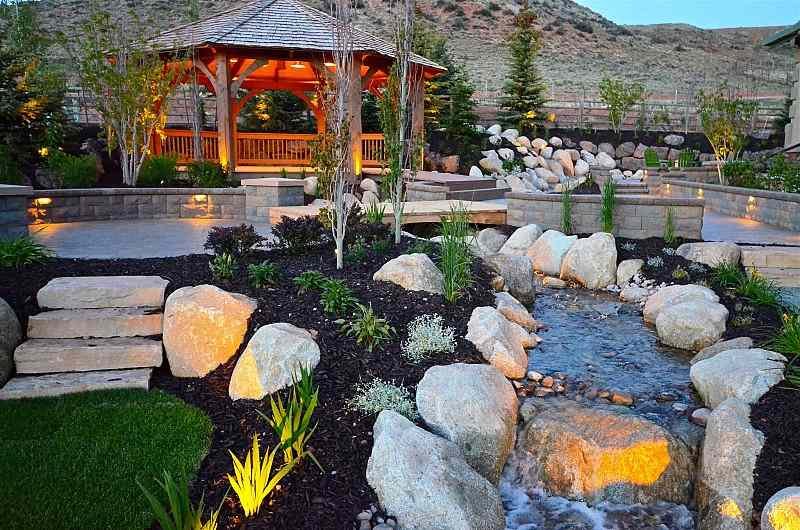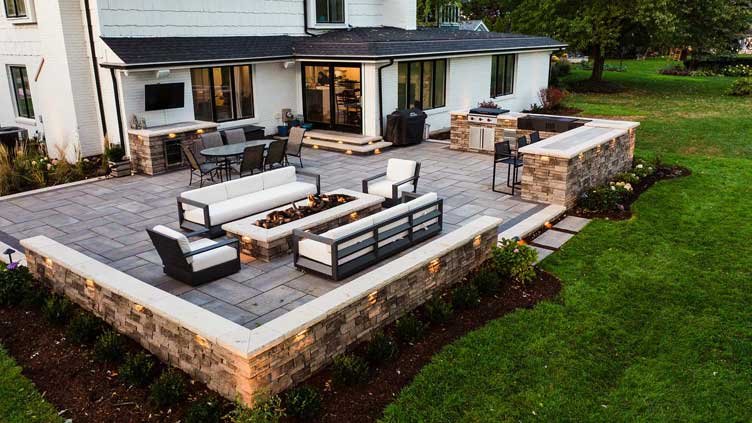Hardscaping is the art of incorporating non-living elements into your outdoor space, like patios, walkways, retaining walls, and fire pits. It’s about creating a beautiful, functional landscape that doesn’t just rely on plants. Hardscaping adds structure, durability, and a unique design to your yard, making it easier to maintain and enjoy. Whether you’re looking to create a cozy outdoor living area or enhance your home’s curb appeal, hardscaping can make a huge difference. At Hoskins Landscaping Contractors LLC, we specialize in crafting stunning hardscapes that bring your vision to life with quality and precision.
What Is Hardscaping?

Hardscaping refers to the use of non-plant elements in landscaping, such as patios, walkways, retaining walls, and outdoor kitchens, to create structure and functionality in outdoor spaces. These features are typically made from durable materials like stone, brick, and concrete. Hardscaping services include design, installation, and maintenance of these elements, enhancing both the aesthetic and practical aspects of your landscape. Professionals ensure that each hardscape is built to last and complements the overall outdoor design, increasing property value and usability.
Hardscaping refers to the non-plant elements of landscaping. It includes everything from patios, walkways, and retaining walls to fences, fire pits, water features, and even outdoor kitchens. Essentially, it involves the use of materials like stone, brick, concrete, wood, metal, and gravel to create structure and form within an outdoor space. While plants add color and life to a garden, hardscaping creates the framework that brings everything together.
The term “hardscape” contrasts with “softscape,” which refers to the plant-based elements like trees, shrubs, flowers, and grass that contribute to the natural beauty of a landscape. Both hardscaping and softscaping are vital in designing an outdoor space that is not only visually appealing but also functional and sustainable.
Why Hardscaping Matters
You might be wondering, why should you focus on hardscaping in your yard or garden? After all, plants are often the first thing that come to mind when imagining a beautiful outdoor area. However, hardscaping brings numerous benefits to any landscaping project, making it a crucial part of the overall design. Here’s why hardscaping matters:
1. Adds Structure and Definition
One of the primary benefits of hardscaping is that it helps define your outdoor space. In a large, open yard, it can be easy for areas to blend together, leaving the space feeling chaotic and undefined. Hardscaping elements like walkways, patios, and retaining walls divide different areas, creating distinct zones for lounging, dining, playing, or relaxing. For example, a stone pathway can lead guests from your front door to the backyard, providing clear direction while adding charm to the space.
2. Enhances Aesthetic Appeal
A well-designed hardscape can be just as beautiful as your plantings, offering texture, color, and pattern that complement your greenery. Stone pathways can add rustic charm, while sleek, modern concrete features can give a contemporary touch to your yard. Retaining walls can be used to create elevation and dimension in a flat landscape, while fire pits and water features add both beauty and atmosphere. Hardscaping elements work with plants to create a balanced, harmonious look.
3. Low Maintenance and Durability
One of the most attractive features of hardscaping is its durability and low maintenance requirements. Unlike plants, which require regular watering, pruning, and seasonal care, hardscaping materials are built to last and need minimal upkeep. This makes hardscaping an excellent option for homeowners who want to reduce the time and effort spent maintaining their outdoor space. For instance, a well-laid stone patio or concrete driveway will remain functional and beautiful for many years with little to no attention.
Moreover, hardscaping materials like stone, brick, and concrete are resilient to weather conditions. Whether it’s rain, snow, or the intense heat of summer, these materials won’t wilt or get damaged as easily as plants. This makes them a great option for people in regions with harsh weather conditions or those with busy lifestyles who may not have the time to maintain a traditional garden.
Key Elements of Hardscaping

Key elements of hardscaping include patios, walkways, retaining walls, fire pits, outdoor kitchens, and water features, all designed to enhance functionality and aesthetics in outdoor spaces. These elements are crafted from durable materials like stone, brick, and concrete, providing structure and beauty. Decorative gravel services offer an additional layer of design, used for pathways, ground cover, or drainage solutions. Gravel adds texture, color, and a natural look while being low-maintenance and versatile, complementing other hardscape features seamlessly.
There are numerous elements that can be incorporated into your hardscaping design. Let’s take a closer look at some of the most common hardscaping features and how they can be used to enhance your outdoor space.
1. Patios and Decks
Patios and decks are perhaps the most popular hardscaping elements, as they provide a flat, durable surface for outdoor living. Whether constructed from concrete, natural stone, brick, or wood, patios and decks are perfect for dining, lounging, and entertaining. A well-designed patio can transform your yard into a comfortable, functional extension of your home.
Decks are often elevated structures made of wood or composite materials that can add a cozy, intimate feel to your outdoor space, while patios tend to be ground-level and constructed from more durable materials like pavers or flagstone. Both options can be customized with features like built-in seating, fire pits, or outdoor kitchens to increase their appeal.
2. Walkways and Pathways
Walkways and pathways are an excellent way to guide people through your garden or yard while adding visual interest. They can be made from a variety of materials such as stepping stones, gravel, brick, or cobblestones. Whether you opt for a meandering pathway through a lush garden or a sleek, straight path leading to your front door, walkways are functional and beautiful additions to any landscape.
Pathways can also help reduce soil compaction in high-traffic areas, protecting the health of your plants and keeping your yard looking neat and tidy.
3. Retaining Walls
Retaining walls are essential for creating structure in landscapes with uneven terrain. These walls, which can be made of stone, brick, or concrete, are used to prevent soil erosion, control water flow, and create level areas for planting. Retaining walls can be designed to suit the style of your home, from rustic stone walls to modern concrete designs.
They can also serve as decorative features in the landscape, adding visual interest and texture. In addition, retaining walls can be used to create raised garden beds, allowing you to grow plants in areas that may otherwise be unsuitable for gardening.
Hardscaping and Hoskins Landscaping Contractors LLC
Hardscaping plays a crucial role in transforming outdoor spaces, providing both beauty and functionality. At Hoskins Landscaping Contractors LLC, we specialize in creating custom hardscape features like patios, walkways, retaining walls, and fire pits. Our fire pit installation services are designed to add warmth and ambiance to your yard, making it the perfect gathering spot for family and friends. We use high-quality materials to ensure your fire pit is both durable and aesthetically appealing, complementing the overall design of your outdoor space.
At Hoskins Landscaping Contractors LLC, we understand the importance of creating a balanced outdoor space that incorporates both hardscaping and softscaping elements. With years of experience and a passion for design, we specialize in crafting custom hardscaping solutions that not only meet the functional needs of our clients but also enhance the beauty and appeal of their properties.
Whether you’re looking to install a new patio, build a retaining wall, or add a stunning water feature, our team is dedicated to delivering high-quality results that stand the test of time. We work closely with each client to understand their vision and create hardscaping designs that perfectly complement their home and lifestyle.
FAQs
What is the purpose of hardscape?
The purpose of hardscape is to provide structure, definition, and functionality to an outdoor space by incorporating non-plant elements like patios, walkways, and walls. It enhances the aesthetic appeal of a landscape by adding texture, color, and design. Hardscaping also improves durability, reduces maintenance, and creates usable areas that complement the natural beauty of softscape elements.
What is the meaning of hardships?
Hardscapes refer to the non-plant elements in landscaping, such as patios, walkways, retaining walls, fences, and driveways, that provide structure and functionality to outdoor spaces. These elements are typically made from materials like stone, brick, wood, or concrete. Hardscapes work alongside softscapes (plants and greenery) to create a balanced, durable, and aesthetically pleasing environment.
What is the difference between hardscaping and landscaping?
Hardscaping refers to the use of non-living elements like stone, wood, and concrete to create structure and functionality in outdoor spaces, such as patios, pathways, and retaining walls. Landscaping, on the other hand, encompasses both hardscaping and softscaping, which includes plants, grass, and trees. While hardscaping focuses on durable materials and design features, landscaping combines both hard and soft elements to create a cohesive and visually appealing outdoor environment.
What is masonry hardscaping?
Masonry hardscaping involves the use of stone, brick, concrete, or other durable materials to create structural elements in outdoor spaces, such as patios, walkways, retaining walls, and fireplaces. These materials are carefully crafted and laid to form visually appealing and long-lasting features. Masonry hardscaping adds both aesthetic value and functionality, creating a solid foundation for landscaping designs.
What are hard-scape examples?
Examples of hardscaping include patios made of stone or concrete, walkways constructed with brick or gravel, and retaining walls built from stone or blocks to prevent soil erosion. Other hardscape features are outdoor kitchens, fire pits, fences, and decorative water features like fountains or ponds. These elements provide structure, define spaces, and enhance the overall design of a landscape.
Conclusion
Hardscaping is more than just adding stone or brick to your yard—it’s about creating a cohesive, functional, and beautiful outdoor space that enhances your home’s curb appeal, increases its value, and makes your outdoor living experience more enjoyable. From patios and walkways to fire pits and water features, hardscaping adds dimension, texture, and structure to your landscape, making it a vital part of any well-designed yard.
At Hoskins Landscaping Contractors LLC, we are committed to helping you transform your outdoor space with stunning hardscaping features that reflect your style and needs. Whether you’re looking to improve your home’s functionality or simply enhance its beauty, hardscaping is the key to creating the perfect outdoor oasis.
